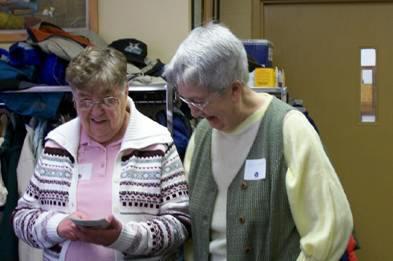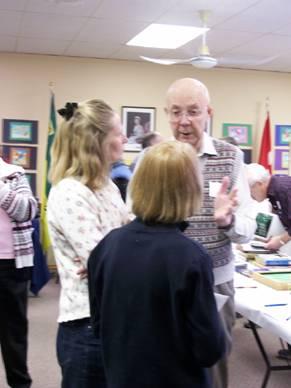Bill and Joyce Anaka
"Storytellers and Naturalists"
By Kathy Morrell.
Joyce Anaka (Right) and Shirley Jowsey discuss a matter of birding importance at the Birding Symposium held in Esterhazy in February 2007.“It takes a birder to put up with a birder,” said Joyce Anaka. Her gaze met that of husband Bill and the two nodded in agreement. Joyce and Bill have spent a lifetime as birders – special people who love nature, but love people, too. As a result, the two are both storytellers and naturalists.
In spring, they say, a young man’s fancy turns to thoughts of love. And so too with the male Sharp-tailed Grouse. And Bill began one of his many stories.
One early spring day when there was just a skiff of snow across the field, one preoccupied Sharp-tailed Grouse danced his way across the lek, the bird’s dancing ground.His tracks in the snow careened in mad abandon from side to side indicating the wonderful show he was creating for the nearby females. Suddenly, in his path, appeared that terrible danger for all dancing males – the badger hole. Preoccupied with thoughts of love, the poor grouse fell in.
On the other side, the bird prints paraded through the snow in plop-plop straight ahead fashion. But never one to give up, the prints further on indicated once more the wild abandon of the dance as the grouse began once more to draw the much anticipated attention of a mate.
The moral of the story – at least according to Bill Anaka – it pays to be a good dancer.
Birds can be territorial and aggressive, too. And the stories continued.
“There were a pair of Eastern Kingbirds close to the yard,” Joyce said. “One day we saw one of them flying just above a martin plucking feathers as he went. He showed that martin who was boss.”
“The male robin will defend his territory, too.” Bill gave another example. “Two male robins will fight. I’ve even seen a male robin scold a squirrel that had the boldness to trespass on his territory.”
And there are the humming birds.
“Those males don’t do a damned thing,” Bill proclaimed. (And I waited for a comment from Joyce. She said nothing practicing the old adage perhaps that silence can be the best part of a good marriage.)
“The male hummingbird is so aggressive.” Bill continued. “He will chase away all comers to the feeders including the females. You have to put up two or three feeders in the yard, so the female has a chance to eat.” You can hear the note of disapproval in his voice.
Bill Anaka, the storyteller, recounts his tales
of the birds to Marlene Brock and Barb Elsasser (left).The stories – and there are many more – indicate that tendency among all birders to attribute human characteristics to the birds. The quality has a fancy name – anthropomorphism. Scientifically it is not accurate, though it brings humour and awareness of the birds and animals.
The Anakas take great pleasure in the birds, but they are curious and painstaking in their record keeping, too.
Their records indicate changes to bird populations. Most species are decreasing – some rapidly. There is less habitat space for birds as more land is used for farming and urban sprawl. There are fewer pot holes for ducks and bluffs for song birds. Huge fields of grain leave precious little habitat for birds. Bill calls these vast tracts a wheat desert.
“The use of pesticides kills the insects, but what kills the bugs kills the birds, too,” Bill explained.
The lumber industry cuts thousands of acres of the boreal forest every year.
“Riparian areas, transition zones between water and uplands, are fast disappearing, too,” Bill continued, his concern for nature obvious in his voice.
Where riparian zones are healthy, plants sink their roots deep in the soil preventing erosion. The vegetation filters out pesticide residue from neighbouring fields. This ground cover slows runoff, increasing the amount of water that is absorbed into the soil and then released slowly into the stream or ground water. And to the birder, the riparian zones are important because they provide shelter and nesting grounds for aquatic birds.
“Bird feeders have helped birds adapt to a decreasing area of habitat,” Bill commented. And the increasing numbers of feeders bear witness to the fact that more and more people are taking the time – not to smell the roses – but to watch the birds.
The lives of Bill Anaka and Joyce Gunn crossed during the annual Christmas Bird Count.
“My reports show that Bill Anaka and Joyce Gunn began to participate in the Good Spirit Christmas bird count in 1953,” reported Alan Smith, wildlife biologist with Environment Canada. “They submitted separate results because they conducted the count on an individual basis. Interestingly enough, after that year, they did a joint bird count and there was only one tally. The counts were submitted in the names of Bill Anaka and Joyce Gunn.”
“In 1971,” he continued, “there was a significant change in name. This time, the bird count came in under the names of Bill and Joyce Anaka. The couple had married in September.”
The Anakas share a life long interest in nature and birding. Bill donated his land to the Nature Conservancy of Canada. The land produces some hay, but for the most part it will stay as it is – a safe haven for all species of birds, plants and animals. The original Gunn property is now part of Good Spirit Provincial Park except for ten acres where the Anakas retire every summer to enjoy the birds and nature.
Return to 'In Tribute' Index


